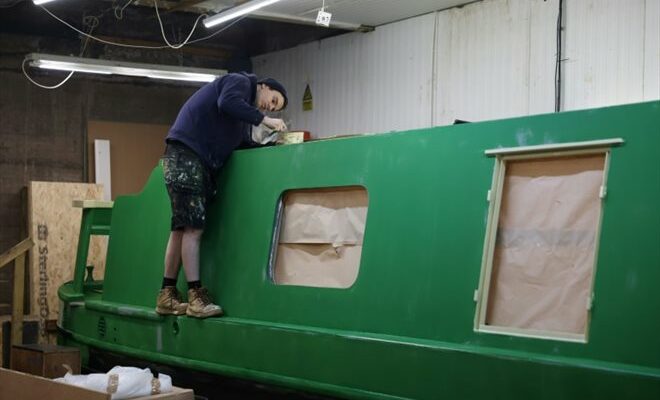Neil Cocksedge, on board his hybrid barge “Eau de Folles”, navigates on a pleasure canal in Ashwood, January 25, 2024 in central England (AFP/Daniel LEAL)
Since the end of the 18th century, canals have crisscrossed all of England; there are even more in Birmingham than in Venice. In these picturesque landscapes, new boats are appearing: electric barges, much more environmentally friendly than diesel ones.
Sailing on the Staffordshire & Worcestershire Canal in central England, Neil Cocksedge’s boat looks at first glance like any other. But he has one particularity: his discretion.
“What people notice with the electric boat is that it is so much quieter,” he proudly tells AFP.
He named his boat “Eau de Folles,” after a now-closed restaurant in Toulouse, southwest France, where he proposed to his wife decades ago.
The batteries that power the engine and on-board appliances (oven, fridge and kettle) are recharged by rooftop solar panels, canalside charging stations and a fuel-powered generator. It consumes four times less diesel than traditional boats.

A screen indicates the battery level and energy consumption of the hybrid barge “Eau de Folies” moored at Ashwood Marina on January 25, 2024 in central England (AFP/Daniel LEAL)
Neil Cocksedge, a retired steel industry executive, is among the pioneers of the transition to environmentally friendly barges, after more than a century of diesel-powered boats.
“We wanted to be as ecological as possible,” explains the septuagenarian, who bought his custom-made pleasure boat in May 2022. “There are very few electric ones at the moment, but they are gaining popularity.”
– Cheaper permits –
The rise of canals in Britain dates back to the end of the 18th century. They were then used to transport goods, contributing to the industrial revolution. In the following century, they were supplanted by the railways.

The electric motor of the hybrid barge “Eau de Folles” moored at Ashwood marina, January 25, 2024 in central England (AFP/Daniel LEAL)
But England and Wales still have more than 3,200 kilometers of navigable canals and rivers. The Birmingham area is the epicenter of this canal network.
A large part is often only a meter wide. This is why these barges are called “narrowboats”.
Sailing both in idyllic countryside and in urban areas, they have experienced a resurgence of interest in recent decades. But the diesel fumes emanating from it look bad as the United Kingdom tries to decarbonize its transport.
The boats are generally equipped with “old modernized agricultural-type engines”, explains Mr Cocksenge.
But the government wants all these boats to be able, from next year, to explain how they can be transformed to achieve the zero emissions objective set by the country for 2050.

Neil Cocksedge, on board his hybird barge “Eau de Folles”, navigates on a pleasure canal in Ashwood, January 25, 2024 in central England (AFP/Daniel LEAL)
To encourage electric motors, the Canal & River Trust (CRT), the organization that looks after the waterways, is offering owners of “green” boats 25% reductions on required annual permits.
It currently licenses around 35,000 boats in England and Wales, but only 1% of these benefit from the reduction, showing how much progress needs to be made.
– Bloggers –
Ortomarine, the company formed in 2015 that built Neil Cocksedge’s boat, decided three years ago to focus exclusively on electric barges.

A carpenter works on wooden planks for a hybrid barge in the workshop of Ortomarine, a company specializing in the construction of electric barges, on January 25, 2024 in Worcestershire (AFP/Daniel LEAL)
It produces up to six boats a year and has a full order book until 2027, explains Caroline Badger, the financial director, from the company’s small workshop on a former military site southwest of Birmingham.
Its boats cost at least £150,000 (€176,000), around £25,000 more than many diesel-powered boats.
These narrowboats are “ideal” for electric propulsion, she says, because they have enough room for solar panels and they sail slowly.

An employee paints a hybrid barge in the workshop of Ortomarine, a company specializing in the construction of electric barges, on January 25, 2024 in Worcestershire (AFP/Daniel LEAL)
Bloggers posting images of life on the canals have largely contributed to the interest in electric boats, particularly after the pandemic when some abandoned their urban apartments in favor of these boats, says Caroline Badger.
This is of interest all over the world, says the manager, referring to customers from Australia, South Africa and North America.
But the potential is not necessarily the same: “Nowhere else are there as many canals as in the United Kingdom (…) crossing some of the most beautiful landscapes in the world.”
© 2024 AFP
Did you like this article ? Share it with your friends using the buttons below.




